Checking the Atmosphere and Changing the Climate
We look to the skies in this week's Naked Scientists show, to uncover ways to monitor and change the chemistry of the atmosphere. We join researchers on board an air-sampling aeroplane to discover how atmospheric chemistry changes once the sun sets, and we discuss options for engineering the climate if things get too hot. In the news, the Ecuadorian population that may hold the genetic key to a disease-free life, and the rocks that move themselves around in Death Valley. Plus, a targeted muscle re-innervation strategy to afford amputees more powerful prosthetic control.
In this episode
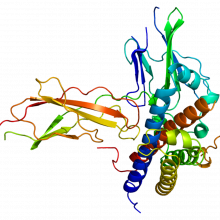
01:50 - Dwarfism Gene - Key to a Long and Healthy Life?
Dwarfism Gene - Key to a Long and Healthy Life?
An isolated population of people in Ecuador could hold the genetic key to a long and healthy life, according to research published in the journal Science Translational Medicine this week.
It's known that mutations in growth signalling pathways can extend life span and reduce genetic damage in model organisms like yeast and nematode worms, and even reduce insulin resistance and cancer rates in mice.
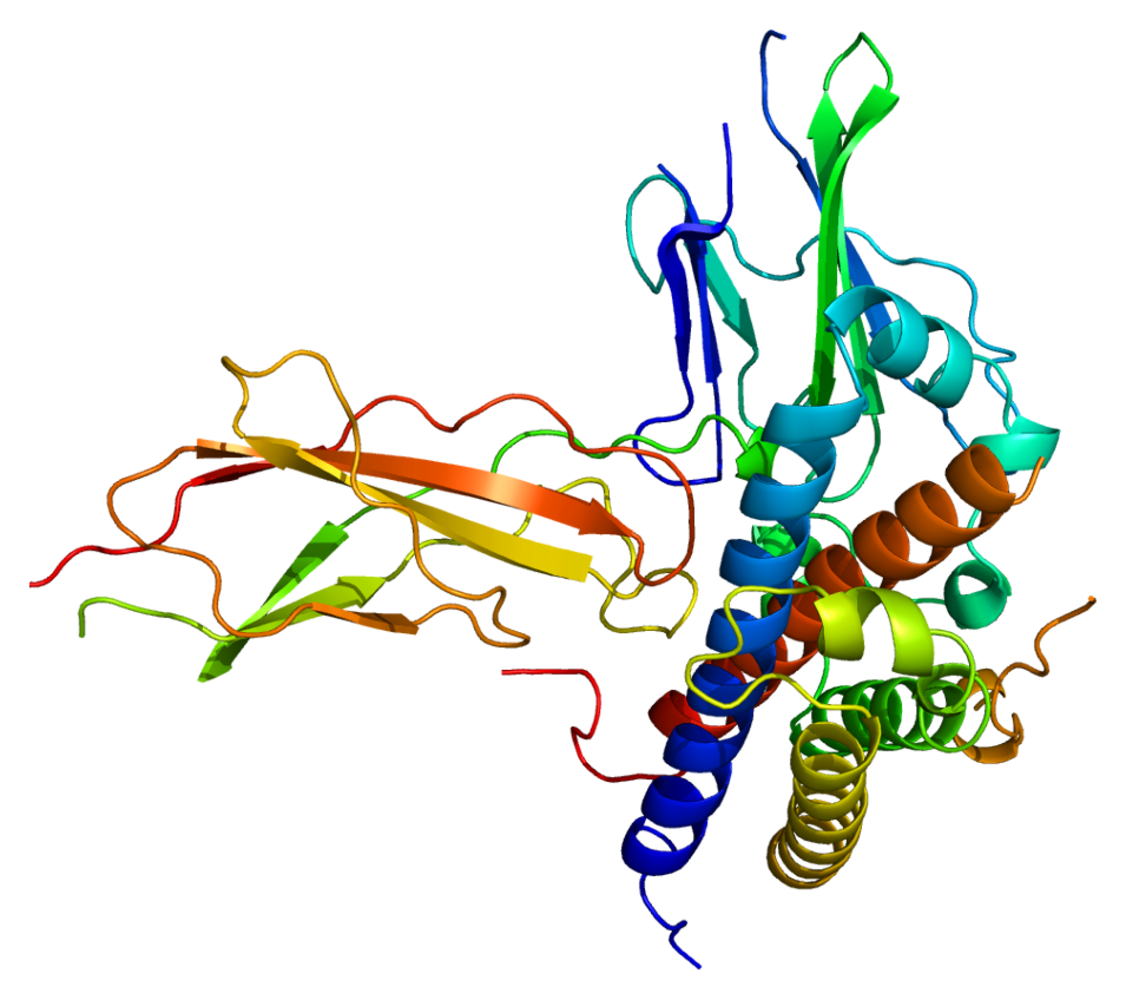 To find out what effect mutations in similar genes may have on humans, Jaime Guevara-Aguirre at the institute of Endocrinology, Metabolism and Reproduction, in Quito, Ecuador; Valter Longo at University of Southern California, and colleagues, have studied a group of 99 related people who all displayed a mutation in the Growth Hormone Receptor or GHR gene - most of them having the E180 mutation, where the resultant protein lacks eight amino acids, and as such cannot fold into the correct shape. As a result of this mutation, their growth is limited.
To find out what effect mutations in similar genes may have on humans, Jaime Guevara-Aguirre at the institute of Endocrinology, Metabolism and Reproduction, in Quito, Ecuador; Valter Longo at University of Southern California, and colleagues, have studied a group of 99 related people who all displayed a mutation in the Growth Hormone Receptor or GHR gene - most of them having the E180 mutation, where the resultant protein lacks eight amino acids, and as such cannot fold into the correct shape. As a result of this mutation, their growth is limited.
The subjects themselves have been observed since 1988, and information on illness and death has been collected for a further 53 GHR-deficient relatives, and 1606 relatives of the cohort that were not affected by GHR-deficiency. This allowed the researchers to look at causes of illness and death in the two populations to see if there were any significant differences.
Cancer accounted for 17% of all diseases, and 20% of deaths in the unaffected relatives, but was not recorded as a cause of death for anyone in the GHR-deficient population. Likewise, there were no reported cases of diabetes in the affected population, and blood tests revealed significantly lower levels of insulin - this tells us that something about this mutation increases insulin sensitivity. However, there was no evidence of an extended lifespan, probably due to the high proportion of deaths caused by non-age-related causes like convulsive disorders, alcohol toxicity and accidents.
To try to explain why this might be, the researchers took human cells and incubated them with serum from either the GHR-deficient subjects or their non-affected relatives, before exposing these cells to a highly oxidising solution of hydrogen peroxide. While individual cells incubated with the GHR-deficient serum showed less DNA damage, there was also higher levels of apoptosis, or programmed cell death, amongst these cells. This suggests that the cells tend to self-destruct rather than accumulate DNA damage.
The authors suggest that their results "provide a foundation for further investigation into the role of drugs blocking the GHR to prevent or reduce the incidence of cancer, diabetes, and other age-related diseases."
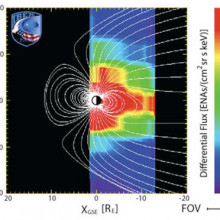
05:21 - Picture of Earth's plasma tail
Picture of Earth's plasma tail
The northern lights have recently been in the news this week, and they are caused by the solar wind, which is made up of energetic charged particles thrown off the sun being trapped by the earth's magnetic field then crashing into the atmosphere exciting the air molecules, making them glow. Unfortunately for those trying to understand this the moving charged particles are effectively an electric current, and electric currents produce a magnetic field, altering where the particles path, changing the magnetic field etc.
To make it even more difficult, the charged particles are essentially invisible as they fly through space, and the effect they have on the magnetic field is only measurable by actually putting an instrument in that position, and there is a limit to the number of satellites you can use at once.
The Interstellar Boundary Explorer or IBEX satellite was actually designed to look at the heliopause which is where the sun's magnetic field and solar wind becomes overwhelmed by the galactic solar wind. At this junction sometimes a charged nucleus will pick up electrons becoming a neutral atom, these are then unaffected by magnetic fields, and will continue in a straight line, only affected by gravity. So if some of them reaches IBEX satellite you can measure the direction they came from. IBEX has built up some interesting pictures of the heliopause, but sometimes in its orbit it looks at the earth where something very similar is happening where the earth's magnetic field is being overwhelmed by the sun's magnetic field.
The result is an admittedly low resolution image of the magnetic tail or plasma sheet that streams out behind the earth. Dave McComas who is the principal invetigator on the mission has published two images of this tail, and they show it is a very dynamic place with an image from one orbit showing it as a smooth tail, but the second has a lump of plasma being pinched off, much closer to the earth than current theories were expecting, possibly because the tail was being squeezed by the solar wind.
Understanding these processes is becoming more important as the sun is moving into a more active part of its 11 year solar cycle and solar storms have knocked out satellites, telegraph and even electricity grids, and it is an interesting example of an instrument designed to investigate something very abstract being used much closer to home.
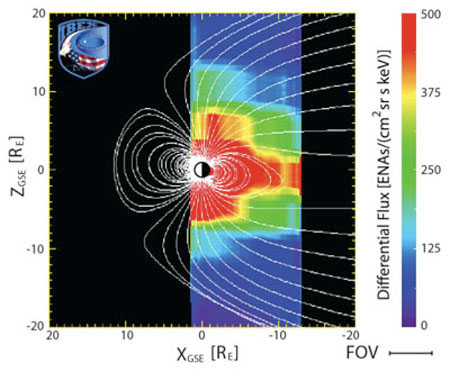 | 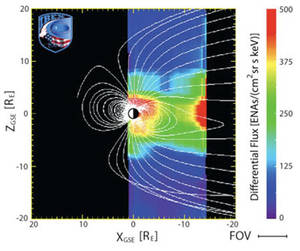 |
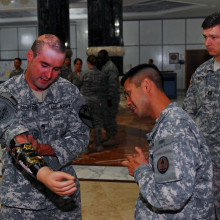
08:06 - Targeted Muscle Re-Innervation Pushes Prosthetic Performance
Targeted Muscle Re-Innervation Pushes Prosthetic Performance
with Dr Todd Kuiken & Martin Baechler, Rehabilitation Institute of Chicago; Sgt. Glen Lehman
Ben - When somebody loses a limb, although it's possible to replace the missing part with a prosthesis, making it move is another matter entirely. But a technique being pioneered at the University of Chicago could change that.
Todd Kuiken has been experimenting with targeted muscle re-innervation surgery, and what he does is to take the nerves that used to supply the severed body part and reroute them into a piece of muscle further up the limb. Now, when the patient thinks about moving the missing body part, the rewired muscle will change its activity instead. By using electrodes to eavesdrop on that activity, it can be used to control the motors of a prosthetic arm.
Chris Smith met with Todd Kuiken and his patient Sgt. Glen Lehman, who's actually undergone this procedure, at the AAAS Conference in Washington DC...
Todd - Our big challenge is how to control an artificial limb. You lose your arm and we can make robotic limbs, but how do you tell it what to do? So we've developed a technique that we call targeted muscle re-innervation where we've developed a neural interface to capture what the person wants to do with their limb. Essentially, the way it works is we take the major nerves that used to go to the amputated arm, and they're still functional. They send motor commands, and if you'll stimulate them, you'll feel the missing arm. So we take those nerves and we transfer them to some spare muscles in the residual limb. Those nerves will then grow into those muscles and when they - Glenn for example - thinks to close his hand, now his medial biceps contracts, and we can detect a signal from that muscle contraction and tell his artificial hand to close. In this way, we can get much more function and its intuitive. He thinks to close his hand. His hand closes.
 Chris - Glenn, can you give us a demonstration?
Chris - Glenn, can you give us a demonstration?
Glen - I can.
Chris - First of all, talk us through what actually happened to you and how long have you been using the prosthesis you've got?
Glen - November 1st, 2008, I lost my arm. I was on a combat patrol in Iraq, they threw an RKG-3 hand grenade at my truck, it penetrated the armour and separated or amputated my arm. After that, I was evacuated and sent through Walter Reed where I received treatment. Dr. Baechler and Dr. Kuiken came to me and asked me if I would be a candidate for the targeted muscle re-innervation surgery, and then just this last week, I received this arm or went out to IRC in Chicago, and trained with them with this arm.
Chris - Can you show us what it can do?
Glen - I can raise them lower the elbow, I can rotate the hand, so it's in our out. I can open and close the hand, and I can flex the wrist either in or out. Those movements were all controlled by me, thinking about my phantom limb.
Chris - So you're thinking about moving fingers that you no longer have, but are present on the prosthesis obviously, and those thoughts are being translated into what the prosthesis does.
Glen - Yes, that's correct.
Chris - Is it easy to learn to do?
Glen - I've only used this arm for two weeks, so it was very easy.
Chris - What sort of resolution of movements can you manage? If I gave you some peas to pick up, could you do that?
Glen - I believe I could, yes. The larger the item, the easier it is to actually grasp. I mean, a bottle of water or something like that is easier. It's very hard to pinch things off the table.
Chris - If you didn't have this, what would you have instead and in what way has this enriched your life?
Glen - I would just have a conventional arm. I would be able to operate the elbow and the hand, but it wouldn't be simultaneous. I would only be able to cycle through each thing by switching co-contracting muscles. So it's like the comparison between a minivan and a sports car. It's different categories.
Chris - Martin [Baechler], you had to do some of the surgery to make this feasible. What's actually involved in implementing a prosthesis like this in terms of actually rerouting the nerves to muscles and so on?
Martin - Well the performance of the surgery is actually very simple. The anatomy is predictable and the procedures of transferring the severed nerve to a healthy piece of muscle is quite simple.
Chris - How long does it take patients to actually begin to use and work one of these prostheses?
Martin - Well since we put the severed nerve so close to the new muscle, it only takes a couple of months before we start getting some contraction of the muscle. It may take six months or maybe even a year before it fully matures and the connection between the brain and that newly innervated muscle is plateaued and it's what's going to be.
Chris - Just coming back to you Todd, in terms of actually how the process works, so there are actually, physically, electrodes which are listening to what the muscle is doing when Glen thinks what he wants to do.
Todd - That's correct. We have sets of little electrodes that are like antennas, listening to his muscles.
Chris - If he had had his injury 20 years ago compared to very, very recently - you got to him when it was a fresh injury, would that have made a difference to whether this could be done?
Todd - It may have. The answer isn't really known. We're comfortable doing the surgery for 5 or 10 years after injury in a younger patient, but there may be a limit someday that we'll find, that we don't want to cross over. We know that the nerves are still viable for decades after the injury, but how good they are at regenerating is a question.
Chris - And what about sensation because at the moment, he obviously can see what he's doing, but he can't feel what he's doing. What about taking it into that domain next?
Todd - We have been able to provide hand sensation for some of our amputees. What we do is cut the nerve to the skin over these nerve transfers and then the hand sensation nerves will grow into this residual limb skin. So when you touch it, it feels like your touching the missing hand. It's very exciting for us because it gives us potential of putting sensors in the prosthesis to see when you touch something or how hard you're squeezing and feed that information back, so that the patient feels that they're getting that touch or pressure on their missing hand.
Ben - And if this prosthetic is like a sports car compared to the traditional minivan, then just imagine what it would be like when you can feel what your prosthetic is touching as well. That was Todd Kuiken, Martin Baechler and Sgt. Glen Lehman, speaking to Chris Smith at the AAAS Conference in Washington this week.
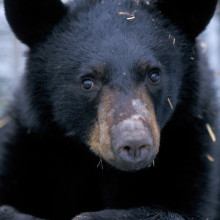
14:23 - Black Bears may send us to the Stars
Black Bears may send us to the Stars
Alaskan black bears do not hibernate in the same way as other, smaller, mammals and an understanding of how they achieve their winter's rest may help improve medical care and open the door to deep space travel.
Hibernation is a very useful behaviour in challenging environments. By slowing the metabolic rate, an animal is able to cut its energy costs dramatically and survive a harsh winter on bodily reserves alone. In general, metabolic rate slows by 50% for every 10 degree Celsius drop in body temperature.
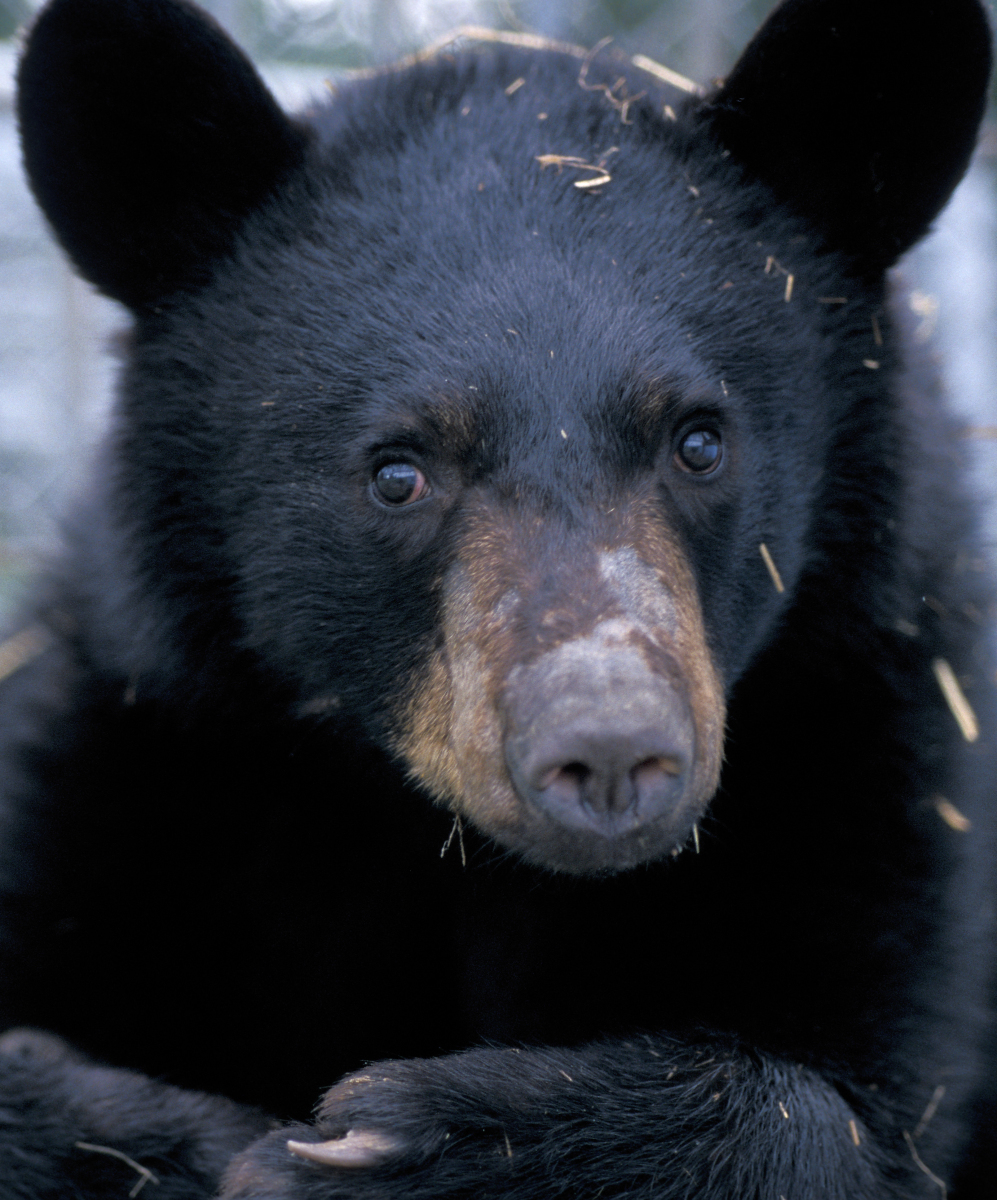 Most of the hibernating animals studied so far, generally small mammals like hedgehogs, typically reduce their body temperature to around their freezing point for weeks on end, with occasional breaks when the body temperature rises to normal for a day or so. These breaks are thought to allow opportunities to repair any nerve damage resulting from the hibernation itself, and account for around 80% of the animal's energy costs during hibernation.
Most of the hibernating animals studied so far, generally small mammals like hedgehogs, typically reduce their body temperature to around their freezing point for weeks on end, with occasional breaks when the body temperature rises to normal for a day or so. These breaks are thought to allow opportunities to repair any nerve damage resulting from the hibernation itself, and account for around 80% of the animal's energy costs during hibernation.
Larger animals, like bears, have been harder to study due to technical limitations. Writing in the journal Science, researchers at the University of Alaska Fairbanks, along with colleagues from Stanford University, have had a unique chance to study five Alaskan bears captured by the Alaska Department of Fish and Game as nuisance animals. Øivind Tøien and colleagues allowed the bears to hibernate in artificial dens, which were kitted out with infrared cameras, activity detectors and other remote sensing devices, and monitored them throughout five months of hibernation. They measured oxygen concentration in the air, as a marker of metabolic rate, and surgically implanted radio transmitters in the bears to report on temperature and heart activity.
This allowed them to see that black bears reduce their metabolic rate to just 25% of it's normal level, despite staying warm - 33 degrees on average. Their heart rates dropped from around 55 to just 14 beats per minute, and showed marked sinus arrhythmia - variation in frequency relative to breathing. This suggests that the bears have mechanisms to divorce metabolic rate from body temperature, allowing them to spend long periods without eating, drinking or defecating, but without the need to be cold. On leaving hibernation in spring, the bears did not instantly return to a high metabolic rate. This instead developed over the next two to three weeks. Also, unlike humans, who lose muscle and bone during a period of inactivity, bears do not seem to suffer this loss.
As well as improving our understanding of how large animals cope with harsh conditions, this could help us to develop novel medical interventions. Brian Barnes, the senior author of the study said:
"If we could discover the genetic and molecular basis for this protection, and for the mechanisms that underlie the reduction in metabolic demand, there is the possibility that we could derive new therapies and medicines to use on humans to prevent osteoporosis, disuse atrophy of muscle, or even to place injured people in a type of suspended or reduced animation until they can be delivered to advanced medical care."
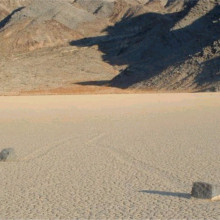
17:26 - Mysterious death valley moving rocks
Mysterious death valley moving rocks
In almost perfectly flat dry lakebed at the upper end of Death Valley there some strange rocks known as 'sailing stones' are dotted about the otherwise almost smooth lake bed, some of them weigh up to 36kg, but behind them are tracks sometimes tens of metres long as if they were moving. The tracks can be straight or zig zagged and some of the stones have been marked and their positions seem to change relative to stakes put in the ground, but noone has ever seen a stone move.
The movements seem to occur on the rare occasions whern the lake bed is covered with a shallow layer of water, there is a strong wind and the temperature is very low. Both ice bergs and winds which can reach 90mph only a couple of inches above the lake bed have been suggested as ways of moving the stones but neither has been decisive.
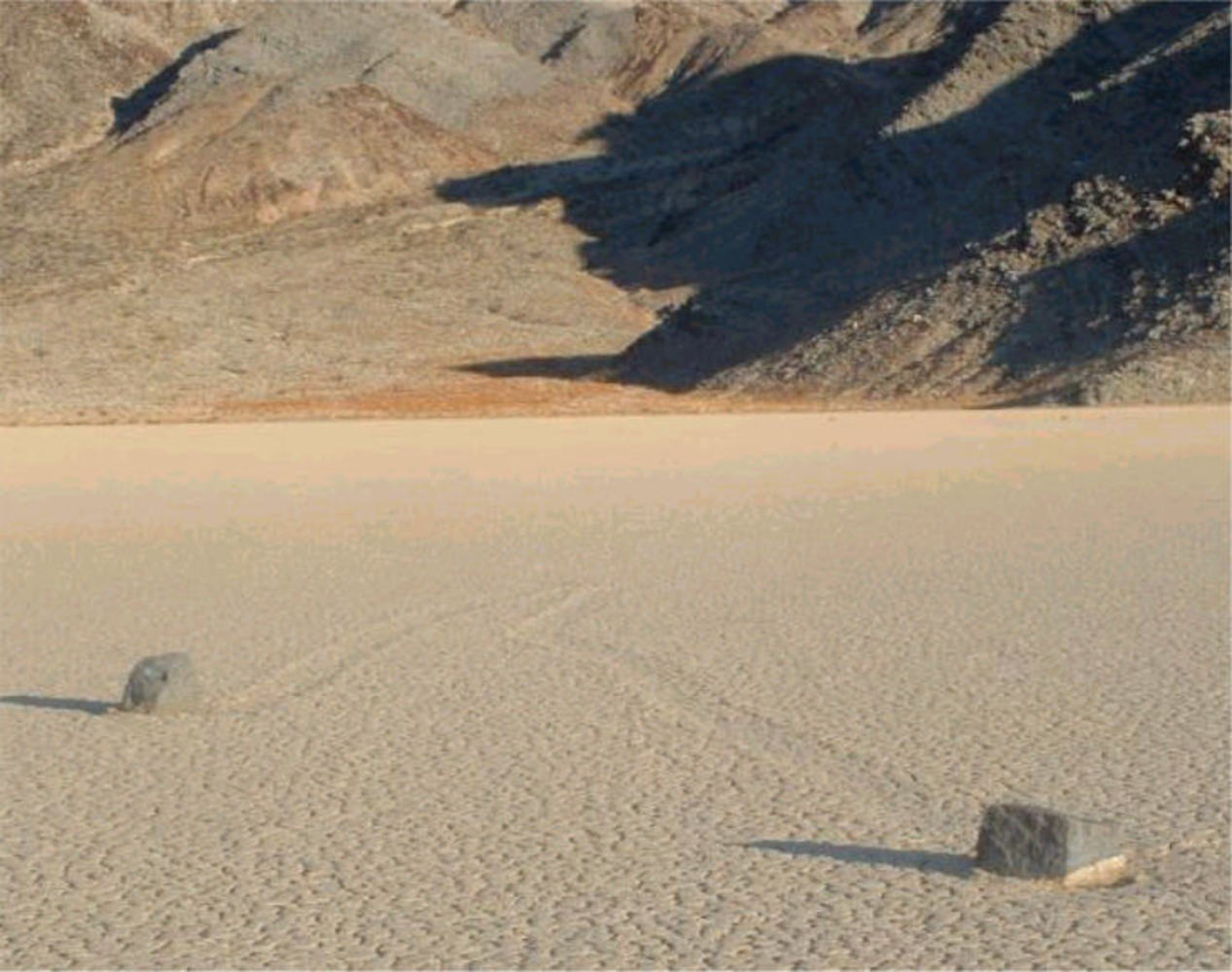 |
| Picture of two rocks on Racetrack Playa in Death Valley. Notice the mysterious groves leading away from the stones. © Maveric149 |
Ralph Lorenz, a scientist at Johns Hopkins University has come up with a new explantion, a neat combination of both. The lake floods a couple of inches deep, and as it does so a small ice berg forms around the stone, the water level increases slightly and beacuse ice floats this gives the stone lift, reducing the friction with the ground. The high winds are then able to push the stones along forming the long tracks. They have done some exeriments which support their hypothesis, though it will be hard to know what is happening for sure until someone actually sees one moving.
This is a lovely mystery, but studying areas like the racetrack playa may be useful in understanting places like the shallow lakes on Saturn's moon Titan, where there are some hydrocarbon lakes which seem to occasionally dry out.
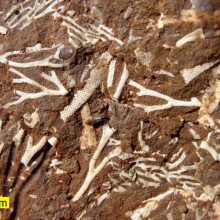
19:40 - Planet Earth Online - Bryozoans and Antarctic History
Planet Earth Online - Bryozoans and Antarctic History
with Dr. David Barnes, British Antarctic Survey
Ben - Scientists are keeping a close eye on the West Antarctic ice sheet because if it's melts, we're in big trouble from the resulting rise in sea level. But how vulnerable is it? Dr. David Barnes from the British Antarctic Survey has been trying to find out by studying small marine creatures called bryozoans. Planet Earth podcast presenter, Richard Hollingham joined David to take a closer look at how life on a small rock can tell us about climate change.
David - What we're looking at is a small rock that's been collected from the continental shelf of the Weddell Sea and these small rocks are oases for life that encrusts other substrates, and it's covered by animals including bryozoans.
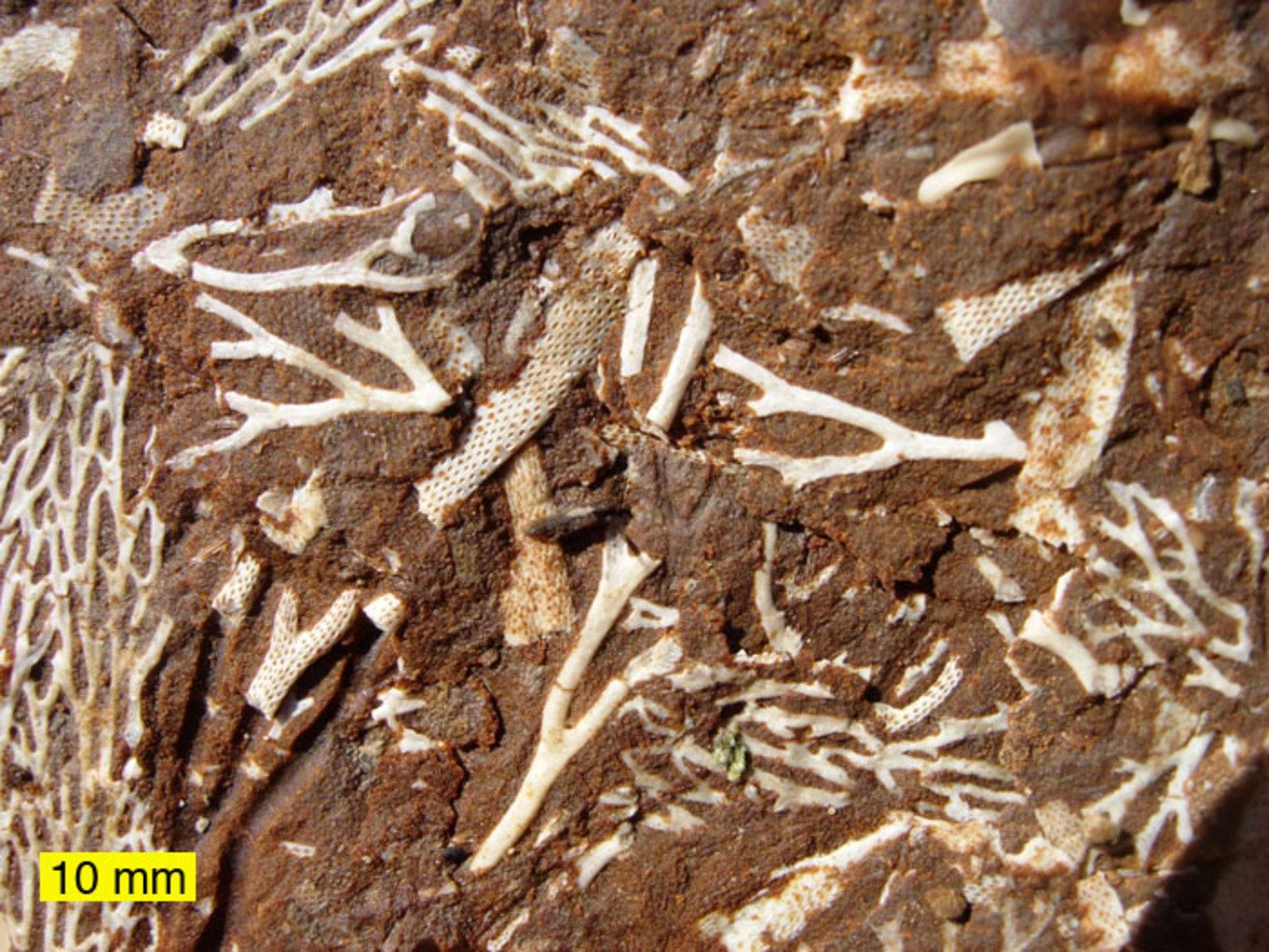 Richard - Just first off, before we look down the microscope, it's really sort of a half fist-size, greyish rock with these white spiral patterns on it. These are the bryozoans...
Richard - Just first off, before we look down the microscope, it's really sort of a half fist-size, greyish rock with these white spiral patterns on it. These are the bryozoans...
David - They are. If we looked at them when they were alive, they would be brightly coloured. Lots of nice oranges, browns, greens, yellows... But when they dry out, they go white. And if you looked at them under the microscope as we're about to do, you can see that these are fighting each other. We're looking at an ancient battleground.
Richard - An ancient battleground. Okay, let's have a look through the microscope here... let's just adjust that... When they're on a rock, they look like someone's drawn spirals, but when you look under the microscope, they're very much three-dimensional, almost like bubble wrap.
David - The spiral is formed by them growing modules out and they're like corals in miniature. So they're going to grow a vast empire of lots and lots of these identical modules. But eventually, they run out of space and they'll meet another set of modules that are growing, and it's like two armies that have met each other on a battleground, and then they will start to either fight or give up because they're too evenly matched. Or perhaps even, if they're very, very closely related in the same species, they'll fuse together to form a giant super organism.
Richard - Now, you went looking for these around the coast of Antarctica. What did you find? What surprised you?
David - We found that if we looked at all of the suites of species that lived in a particular site, in a particular area, and scaled it up to a whole sea, the Weddell Sea, we wanted to try and see where was that most similar to. Now logically, you would expect it to be most similar to the areas nearby, these animals find it hard to get around. And to some extent, that's what we found, but with one big exception.
Richard - And that was...?
David - And that was the Weddell and the Ross seas. These seas are long way apart. They're separated by one of the three big lumps of ice that exist on the planet - the West Antarctic ice sheet and we don't know how stable that has been in Earth's past, but we need to know because it could be crucial for sea level rise. The fact that these two areas that are maybe 1500 miles apart, separated by this massive block of ice [shared bryozoans] was a real surprise and it tells us that at some point, those have been recently connected.
Richard - So what's the significance then of these two seas, thousands of miles apart, being connected?
David - If we want to understand how our planet is going to respond to the warming that's going on at the moment, which is fairly unprecedented in the last 30 million years, we need to know how ice sheets have responded to climate in the past. We can only project the future, but we actually have data on the past. So we can go back and look at how each of the three big ice sheets has responded to past temperatures, that we have a very good record of through ice cores and sediment cores. If we look at each of those, the East Antarctic sheets - the biggest by far is very, very stable. The other two, we aren't quite so sure of and a lot of attention is focused on Greenland. But if we are right, it might mean that the West Antarctic ice sheet is the least stable of those three, and the most important to projected sea level rise with our temperatures. And so, getting an idea of where and when that collapsed was becomes very, very important - for example, the last interglacial was a very brief one that was very warm, and that's like our current time now, brief but warm. And so, if it did collapse in the last interglacial, that means that all of our previous thoughts were wrong, that it was too brief for the ice to collapse. Well, if it wasn't, then that's an important look forward to our immediate future.
Ben - David Barnes from the British Antarctic Survey, talking to Richard Hollingham.
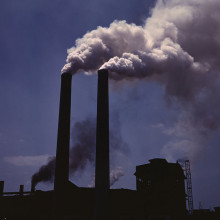
24:39 - Sampling the Atmosphere and Tracking Pollution - the RONOCO Campaign
Sampling the Atmosphere and Tracking Pollution - the RONOCO Campaign
with Professor Rod Jones and other researchers involved in RONOCO
Ben - How do we study the atmosphere? We have a vast array of tools and chemical tricks that we can rely on, but the atmosphere is a very dynamic thing. So sampling the air in just one place can only tell us so much. Now, an international consortium of scientists and organisations including the MET office, the Natural Environment Research Council, have taken to the skies in a modified BAe-146 airliner to explore what happens to atmospheric chemistry once the Sun goes down...
Rod - Mission to Mission 2.Mission2 - Go ahead.
Rod - Just to say that we're just about to enter the top of the cloud layer, so instruments need to perhaps just be aware of that.
Mission2 - Okay, copy that.
Rod - Mission to instrument scientists, we're descending hopefully into the pollutant layer...
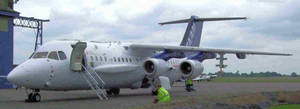 Ben - The RONOCO campaign, that's short for ROle of Nighttime chemistry in controlling the Oxidising Capacity of the AtmOsphere, allows scientists from all over Europe to study the atmosphere in a unique way. Atmospheric chemistry changes when the Sun, a driver of many chemical reactions, goes down. So, by setting off on a modified airplane at dusk and following the plumes of pollution into the night, the scientists on board can get a far better understanding of the pervasiveness and importance of night time chemical processes. To know when and where to track this pollution, the researchers rely on weather reports from the MET office as part of their daily teleconference. Here's Dave Kindred...
Ben - The RONOCO campaign, that's short for ROle of Nighttime chemistry in controlling the Oxidising Capacity of the AtmOsphere, allows scientists from all over Europe to study the atmosphere in a unique way. Atmospheric chemistry changes when the Sun, a driver of many chemical reactions, goes down. So, by setting off on a modified airplane at dusk and following the plumes of pollution into the night, the scientists on board can get a far better understanding of the pervasiveness and importance of night time chemical processes. To know when and where to track this pollution, the researchers rely on weather reports from the MET office as part of their daily teleconference. Here's Dave Kindred...
Dave - I think it's going to be looking and chasing the clearer patches after today. I think today is going to be the best flying day we've got in the next several, and I think plans to fly along the English Channel. I think that's still the best area for today and around the Southwest approaches may be the Bristol Channel...
Ben - Armed with this knowledge, Cambridge University's Professor Rod Jones, a Mission Scientist on the RONOCO campaign can start to make decisions about the course that they will take.
Rod - What I'm going to be doing is sitting next to the pilots in the cockpit. I'll have a certain amount of information from the crew and the scientists at the back, telling me what the atmosphere looks like, and we'll be making judgements about where to go, on the basis of what we actually see because we're using forecasts to give us a good idea to where we should be broadly, and we're going to use the measurements we make on the airplane to try and refine that and put it exactly in the right spot.
Ben - That was Rod Jones. Karen Hornsby from the University of Leicester is one of the scientists on board.
Karen - Because we're looking at the boundary layer which is quite close to the surface, we have to go as close to the surface as we possibly can. So, during the day over the sea, we can get down as low as 50 feet which is quite exciting when you're stood up strapped to your rack for safety, looking out the window and seeing the waves whipping by. But obviously at night, it's more dangerous to go that low, so we've been flying more like 1500 feet over the ocean and it's still fairly exciting.
Ben - The plane itself is packed with scientific instruments, each measuring, sampling or monitoring a different aspect of the atmosphere. Ruth Purvis, from the University of York introduces us to the core chemistry instruments.
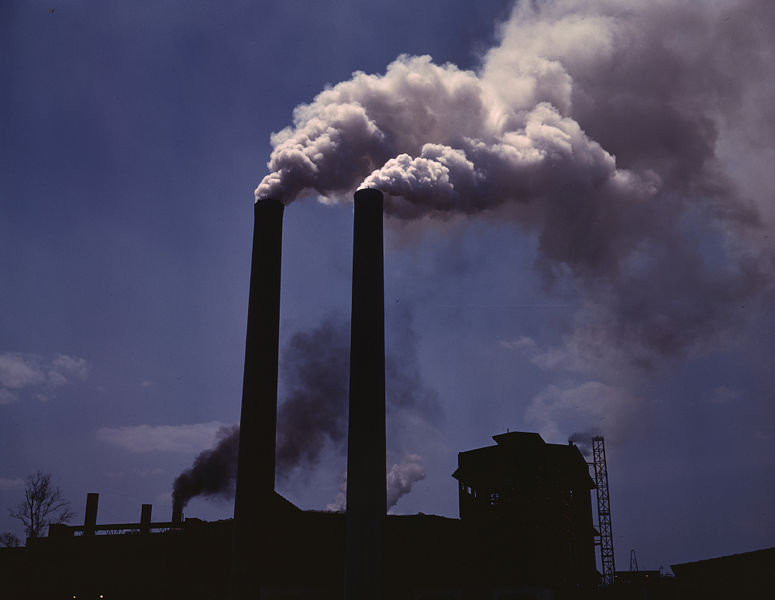 Ruth - This is a set of instruments that is on the aircraft, every time it flies, so it tends to be part of what we call a core instrument fit and we have an ozone analyser, a carbon monoxide analyser, and NOx analyser - that's nitrogen dioxide. The most important two on this rack really are the ozone and the carbon monoxide monitor. These are both key atmospheric tracers. We have carbon monoxide which is what we call an anthropogenic tracer and that just means that it's a man-made pollutant really. You will see high amounts of carbon monoxide in all kinds of plumes that we're tracing. The ozone tends to be in really strong polluted plumes, so we can use both these measurements to see when we're in the plume and they're really good markers for that.
Ruth - This is a set of instruments that is on the aircraft, every time it flies, so it tends to be part of what we call a core instrument fit and we have an ozone analyser, a carbon monoxide analyser, and NOx analyser - that's nitrogen dioxide. The most important two on this rack really are the ozone and the carbon monoxide monitor. These are both key atmospheric tracers. We have carbon monoxide which is what we call an anthropogenic tracer and that just means that it's a man-made pollutant really. You will see high amounts of carbon monoxide in all kinds of plumes that we're tracing. The ozone tends to be in really strong polluted plumes, so we can use both these measurements to see when we're in the plume and they're really good markers for that.
Ben - Sarah Moller, also from the University of York runs the N.O.x or NOx rack.
Sarah - Nitrogen oxides are generally produced wherever the temperature is high enough for nitrogen and oxygen in the air to join together to form nitrogen oxide, so that's combustion, anything like that. So when you see pollutant plumes, they often include NOx, and that's what we measure with this instrument. So what it does is it sucks air in from the outside and it makes NO2 in the excited state which then gives off light, and we measure how much light it gives off, and that tells us how much NO or NO2 we've got in the air. During the day, you have NO and NO2, but at night, you don't get NO formed because it's formed by sunlight changing NO2 into NO. So at night, you would expect to see all NO2. So when we do dusk or dawn flights, you see at dusk, the NO starts to disappear as the sunlight goes, and all the processes convert the NO that's there into NO2, and then at dawn, you see as the sun comes up, you start to get the NO2 photolysed and you start to get NO being produced.
Ben - Other compounds of nitrogen are also important as Jennifer Muller from Manchester University explains...
Jennifer - The CIMS stands for Chemical Ionisation Mass Spectrometer, so we're using a compound called methyl iodide, and produce iodine ions, so that's I-, to then have them in a chamber, reacting with the air samples from the outside. The I- locks onto particular compounds that we're interested in. So one compound for example, that's also important for this campaign is nitric acid. So nitric acid is HNO3 and basically, the I- hangs on to the HNO3 and we can see it in our mass spectrum at a particular mass. So, the HNO3, the nitric acid, is one of the nitrogen compounds that we're interested in, the focus being on nitrogen compounds during the night and how they react.
Ben - In addition to nitrogen, the RONOCO campaign looks at a range of other important chemicals. Hannah Bunyan is from the University of Leeds.
Hannah - FAGE stands for Fluorescence Assay by Gas Expansion and it's a low pressure technique that samples air from the outside from the aircraft, so the ambient air. We draw it into a detection cell and then we excite the molecules that we're interested in using a laser. We're want to measure the concentrations of the OH and HO2 radicals, so we tune our laser wavelength so that we can excite the OH radical and then we measure the fluorescence that is produced when the radical relaxes, and that gives us a measure of concentration. And the OH and HO2 together, collectively they're called called HOx. During the day, OH is a really important oxidiser of hydrocarbons and things like that, and it's made by photolysis of ozone, but during the night, there's more ambiguity about what its role is and how it works. It's possible that it's produced by the reactions of ozone with alkenes, but it's also possible that the nitrate radical which is being measured during these flights is also important. So basically, we're trying to give some contribution to how much the OH radical contributes to oxidation at night. So far, it's going pretty well.
Karen - My name is Karen Hornsby and I'm a Research Associate at the University of Leicester, working on the Peroxy Radical Chemical Amplifier or short named, PERCA. My rack basically consists of two half-height metal 19-inch racks, and within it, we store several gas cylinders containing compressed air, nitrogen and nitrogen oxide. We sample gas through the skin of the aircraft using two glass inlets which then go to two detectors which tell me how much nitrogen dioxide I'm generating from the Peroxy Radicals that I'm converting into nitrogen dioxide.
Ben - Gavin McMeeking from the University of Manchester is not measuring gases in the atmosphere, but particles.
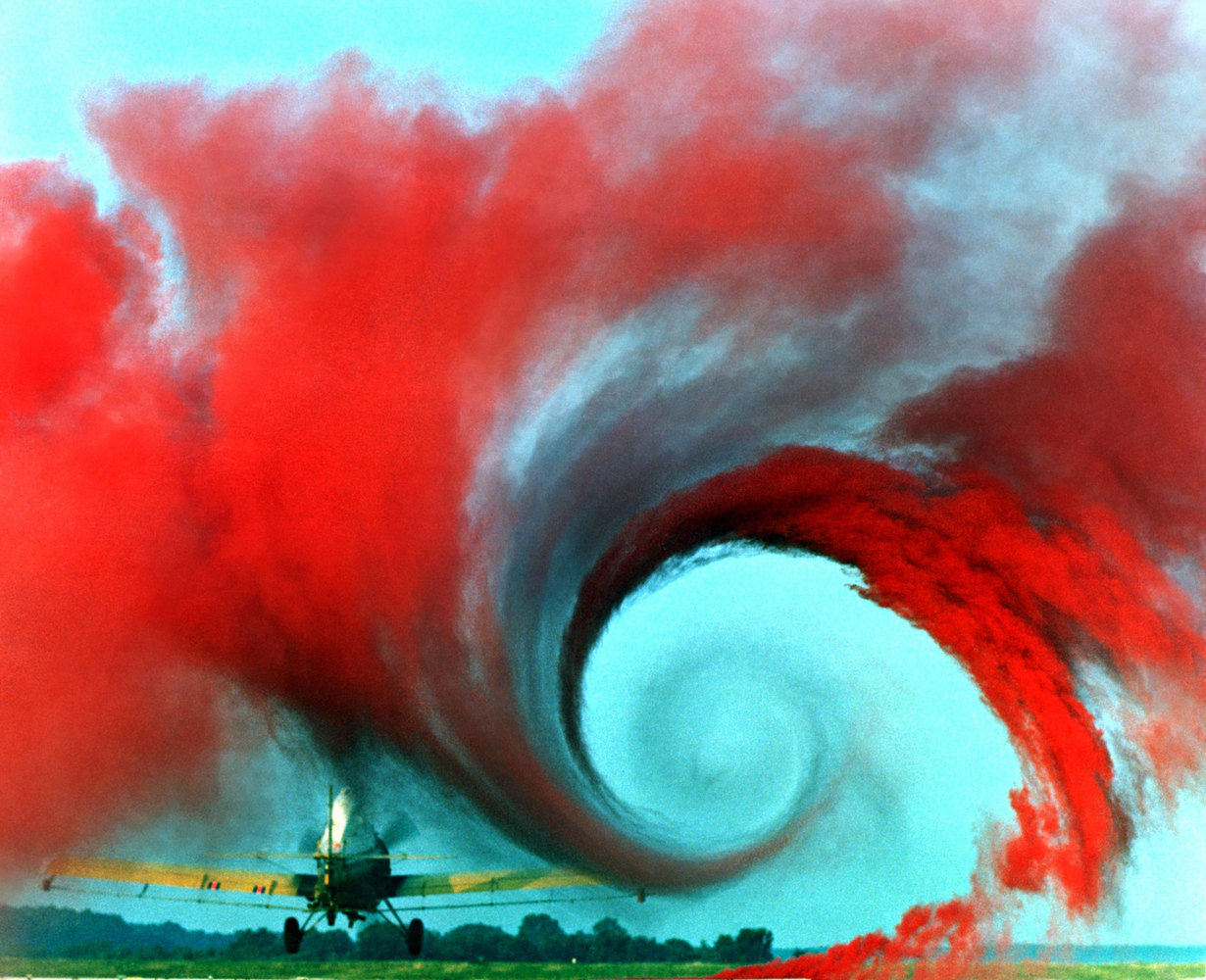 Gavin - This is the aerosol mass spectrometer. It measures small particles that are hanging around in the atmosphere. It's a little different from most of everything else on the aircraft in that it doesn't look at gas phase species, it's looking at these particles. The aerosols have a lot of impacts on the atmosphere and air quality and particularly for the things RONOCO is interested in. For one thing they're an important place where nitrogen ends up, a lot of it can basically turn into nitric acid and eventually go into the particle phase and form things like ammonium nitrate, and this instrument can measure that. The other thing is that the aerosols themselves can be surface sites for a lot of different chemical reactions that happen in the atmosphere. So, that's one of the things that we're interested in trying to characterise - how many particles are around at different parts of the flight, where we are in different altitudes, that kind of thing, and then also how does that change with time, and are we seeing increases in the amount of say, nitrogen that's in the particles as the evening progresses, or as it gets colder, as it gets more humid, other factors like that.
Gavin - This is the aerosol mass spectrometer. It measures small particles that are hanging around in the atmosphere. It's a little different from most of everything else on the aircraft in that it doesn't look at gas phase species, it's looking at these particles. The aerosols have a lot of impacts on the atmosphere and air quality and particularly for the things RONOCO is interested in. For one thing they're an important place where nitrogen ends up, a lot of it can basically turn into nitric acid and eventually go into the particle phase and form things like ammonium nitrate, and this instrument can measure that. The other thing is that the aerosols themselves can be surface sites for a lot of different chemical reactions that happen in the atmosphere. So, that's one of the things that we're interested in trying to characterise - how many particles are around at different parts of the flight, where we are in different altitudes, that kind of thing, and then also how does that change with time, and are we seeing increases in the amount of say, nitrogen that's in the particles as the evening progresses, or as it gets colder, as it gets more humid, other factors like that.
Ben - The RONOCO campaign took to the air for the last of their winter flights a few weeks ago and it will take time to understand all the data they've collected. Before their final flight, Michelle Cain explained what they've been able to see so far.
Michelle - We've got a mixture of different weather conditions. To start with, we had fronts coming through and quite strong flow as a consequence. So we saw some really good plumes from Birmingham, Manchester and Edinburgh, so we were able to track those plumes as they came off the coast. Now we've got a bit more - well, a very high pressure system just stagnating over us. It's not a strong flow. It's quite slack winds and we've managed to get one flight the other day over the English Channel. It was quite messy, we saw lots of pollution coming off the UK as a whole, but embedded in that, the London plume. That was a dusk flight so we saw the transition from daytime to night time, so all the photo chemistry just switches off then you see different things starting to appear after dark. So that was very interesting and we're going to try and repeat that today. So it's all in all been pretty successful and we've been quite lucky with the weather, I would have to say!
Pilot - Start of descent. Three - two - one.
Ben - What a fantastic mission that sounds like. We will look forward to finding out what they've discovered some time in the future. Many, many thanks go to Rod Jones at Cambridge University and to Doug Anderson at Cranfield University for their essential help with making that happen.
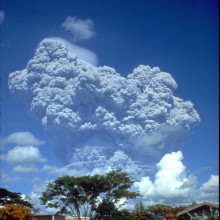
35:24 - Geoengineering - How to Change the Climate
Geoengineering - How to Change the Climate
with Dr Peter Braesicke, Cambridge University
Another reason to try and understand atmospheric chemistry is in case there comes a time when we have to try and do some geo-engineering. If global warming becomes sufficiently serious, we may have to actually do something about it physically, perhaps by adding some chemicals to the atmosphere which will cool things down. Dr. Peter Braesicke is from the Department of Chemistry at Cambridge University. He explained to Dave Ansell what approaches are available to us...
Peter - I think one of the major approaches would be to inject particle precursors into the atmosphere and I think most commonly, people think about things like SO2, like volcanoes would do, and then basically have aerosols forming, and those aerosols reflecting sunlight back to the space.
Dave - So I guess Mt. Pinatubo was a big example of this. That was a big volcanic eruption which shot a load of dust really high up in the atmosphere and actually affected the climate.
Peter - Yes, you're exactly right. So Mt. Pinatubo is one of our big case studies, so to speak. Basically the volcano went off and injected lots of SO2 into the atmosphere, aerosols were formed, and basically on these aerosols, we have then interesting reactions with the ozone. So ozone actually went down after Pinatubo erupted and then recovered afterwards, giving us a nice chemical tracer in the atmosphere. Also, obviously, it had repercussions on the heating rates in the atmosphere. So Pinatubo cooled, globally, the atmosphere, even though it caused something which is called winter warming. So actually, one of the winters after Pinatubo actually was slightly warmer on average in our latitudes and in our areas than it usually would be without the Pinatubo explosion.
Dave - So is this because the dust is acting as an insulator, so if you're somewhere very warm, it's keeping heat out, but if you're in deep winter, it's going to keep some of the heat in?
Peter - Yes, it's true. That's part of the thing as well, but as we've discussed today earlier, there will be changes in terms of the circulation and circulation patterns obviously have some kind of consequences for what kind of temperatures we have locally and for the local weather we experience in our region. And so, those circulation changes affect us in a way that we end up with a slightly warmer northern hemisphere.
Dave - So, the circulation in the atmosphere is being driven by temperature differences. The equator is very, very warm so air is rising there and other places where it's cold the air is sinking. And if you affect the amount of light and therefore heat which is coming in to an area, you're going to affect the circulation with respect to that.
Peter - That's exactly right and also, the vertical structure is very complicated. Where you have the aerosol locally high up in the atmosphere, at 15, 17 Kilometres, it actually causes local warming in the atmosphere. Whereas lower down towards the surface, where you have the aerosol scattering light back out of the atmosphere, you actually have local cooling. So you change the vertical structure of temperature and you also change the gradient from North to South, and that then acts as sort of a regulator on how the circulation will change.
Dave - So, it's having effects all over this very, very complicated system.
Peter - Yes.
Dave - So, you're attempting to model some of these effects?
Peter - That's exactly right. So we are running big climate models, at the Centre for Atmospheric Science in the Department of Chemistry at Cambridge University, together with the MET office, and it's basically one of the MET office models that we are using and developing together. And we are looking at what Mt. Pinatubo does to things like ozone circulation, climate at the surface. But also overall, what kind of large transport changes there are in the stratosphere, and how the aerosol has been vectored around and where the aerosol eventually left the atmosphere, and for how long it was around.
Dave - So, I guess one thing you'd be really worried about, doing something like this deliberately, is if you're going to produce what would look like a minor side effect with respect to the whole globe, but with respect to the people living there, it could be absolutely disastrous.
Peter - Exactly, I think that is always what could happen if you basically twiddle around with the climate system. You might get something right like global mean temperature, which obviously is the kind of metric that is important, but that doesn't really tell you anything about your livelihood locally and in any given country. And if you change the circulation such that a monsoon would fall in India then it would have very severe consequences for people there.
Dave - So would you be able to tune how you're injecting your particles to reflect the light to possibly affect the weather relatively locally, so in some areas, you could increase the rainfall or decrease it?
Peter - That might be possible but it is very, very complicated because bear in mind that basically, the circulation in the stratosphere which is the part of the atmosphere above 15 kilometres is very, very global. So it acts on slightly slower time scales than what we see in the troposphere in terms of circulation, but it's so global that basically, within months, aerosol is brought from the tropics to high latitudes. So whatever you do in the stratosphere, you have to think big. You have to think on the global scale and again, it might have repercussions then on a regional scale in the troposphere.
Dave - Is this sort of thing ever likely to actually happen or do you think the legal effects and the general worry of actually something going horribly wrong would stop it?
Peter - Personally, I think it's not very likely to happen. It's something that we need to study and will help us to understand how the atmosphere works, but as you say, there are so many legal issues, ethical issues, that I don't think we will do it in the end.
Dave - But then again I guess, if the world was in a really, really bad state, due to global warming then the side effects might be less than the possible outcome of what's happening anyway.
Peter - It might be. It's very, very hard to say and I think it's mportant that we talk about and think about those things. But I think we have to keep in mind, whatever you do there are winners and losers, and to regulate this in terms of some "global world citizen" view is, I think, an incredibly difficult thing to do.
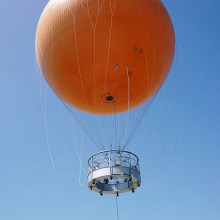
41:17 - Naked Engineering - The SPICE Project
Naked Engineering - The SPICE Project
with Dr Hugh Hunt, University of Cambridge
Meera - The SPICE Project, which stands for the Stratospheric Particle Injection for Climate Engineering, is being undertaken by the universities of Cambridge, Bristol and Oxford, looking into the technology of geo-engineering. This week, Dave and I have come along to the University of Cambridge Engineering Department to find out more of the engineering aspects of this project. One engineer on the SPICE project who's looking into getting this up into our stratosphere is Dr. Hugh Hunt. Now Hugh, first of all, how would you even go about designing this?
 Hugh - Well Meera, you might think, if you want to get some particles up there, you could say, take them up in aircrafts or you might send them up in balloons, but if you actually sit down and work out at the sums of what's possible, that narrows down the scope. The technology that we're looking at is having a balloon right up in the stratosphere, 20 kilometres high. That's twice as high as a normal cruising commercial aircraft, holding a pipe like a big garden hose. Now this hose would be just like a garden hose, 20 kilometres long and we pump stuff up the pipe. The nice thing about it is that we can really have a knob, if you like, which we can control to adjust the rate at which we inject these particles.
Hugh - Well Meera, you might think, if you want to get some particles up there, you could say, take them up in aircrafts or you might send them up in balloons, but if you actually sit down and work out at the sums of what's possible, that narrows down the scope. The technology that we're looking at is having a balloon right up in the stratosphere, 20 kilometres high. That's twice as high as a normal cruising commercial aircraft, holding a pipe like a big garden hose. Now this hose would be just like a garden hose, 20 kilometres long and we pump stuff up the pipe. The nice thing about it is that we can really have a knob, if you like, which we can control to adjust the rate at which we inject these particles.
Meera - This sounds reasonably simple, in that it's a balloon with a tube and you're sending things up the tube, but you are also sending it 20 kilometres up into the stratosphere. We are in one of the workshops here in engineering and you've got a large helium balloon here with a thin metal chain hanging off it...
Hugh - In order to try and understand how a 20-kilometre tether works with the balloon up in the stratosphere, we really do need to make sure we understand smaller scale experiments. So this is great. We've got this chain, just an ordinary bathroom chain, and there's a balloon, you can see it up there. It's quite big, it's getting up to a meter in diameter. It sits up there a few meters up and you can see that if I just give it a whack on the side, the chain starts to wobble over the place, and the balloon starts to bounce up and down. This is going to be happening on a 20-kilometre scale and the tube has got to be able to take the pressure of 20 kilometres worth of weight of fluid. And reinforced garden hose, well we know what that looks like, but the most important thing to notice is that it's reinforced. So if we're going to have to hold back the thousands of atmospheres of pressure which we need to pump the stuff up this pipe, we're going to have to design the reinforcement really well.
Dave - But weight is going to be a really big problem because the heavier the tube is, the bigger the balloon you need, and also, the more tension you've got in that tube.
Hugh - Yes. So the whole weight of this thing is going to be a few hundred tons. That's the weight of several double-decker buses. So imagine how big a helium balloon do you need to hold several double-decker buses - a big balloon! We're looking at a balloon which is possibly 100 or 200 metres in diameter. It's about the same size as Wembley Stadium.
Meera - That's an extremely large balloon. So, we've addressed the fact that you need to take the weight into consideration, the strength, but what about actually pumping things up to that height, and actually spraying it out into the stratosphere?
Hugh - If we're pumping at several thousand atmospheres, and we're having to pump up an abrasive substance for instance, it's an engineering challenge. The pressures are high, the pump has to be designed to take those pressures. Then at the very top, we've got to disperse the material into the stratosphere through some kind of nozzle. If the nozzle would get blocked, it's not like an inkjet printer where you can just replace the cartridge. We won't be able to go up there to do anything. So we've got to make this thing work reliably for months, perhaps years at a time and we're pumping tens of thousands of kilograms of material everyday through this pipe. So, it's a big challenge.
Meera - And what about actually launching the balloon up to such a height?
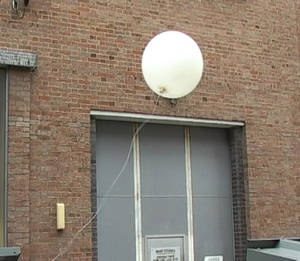 Hugh - The real issues are that you've got your balloon folded up. So it's a bit like if you've got a sleeping bag in a sack and you're trying to get it out of the sack and you're trying to fill it up with helium or hydrogen, and get it launched, and take it up through the windy atmosphere and get it through whatever weather is going on, and get it up to this safe altitude of 20 kilometres, where in the stratosphere, the wind conditions are really much gentler.
Hugh - The real issues are that you've got your balloon folded up. So it's a bit like if you've got a sleeping bag in a sack and you're trying to get it out of the sack and you're trying to fill it up with helium or hydrogen, and get it launched, and take it up through the windy atmosphere and get it through whatever weather is going on, and get it up to this safe altitude of 20 kilometres, where in the stratosphere, the wind conditions are really much gentler.
Dave - I guess also the temperature is changing a lot between the ground and the stratosphere as well.
Hugh - Yeah, one thing we have to try and prevent happening is for any ice build up on the tether. Do we have to make sure the tether stays warm or do we have to put surface coatings on to make sure the ice doesn't form?
Meera - And I guess one way to really see if it's possible is to do a trial.
Hugh - Yeah, that's right and we've got plans in October/November this year to do a test at one kilometre. This is going to be quite a high profile exercise and before we can get permission for this trial we are undergoing a public engagement exercise, which is going on as we speak.
Meera - The design engineer on the SPICE project working on this trial is Kirsty Kuo...
Kirsty - To try and understand better some of the engineering challenges that are involved, we're planning to pump up water up this pipe at a rate similar to that you get with a garden hose. So, though the pressures aren't as high as they would be for the 20km system, it will still help us to understand what type of pump we should use and how well this water flows up the pipe, and whether it causes the balloon and the pipe to move anymore than the wind does.
Dave - So you're doing this as an experiment essentially; So what do you not quite understand which you're hoping to learn by doing this?
Kirsty - What we really want to understand better is how the tether moves in the wind. We know that if you have a helium balloon and you blow on it, it's going to sway from side to side. Now, is that an important issue when launching one of these balloons? Will we see as the balloon goes up to 1 km that the balloon sways from side to side and how much will it sway? We don't really know how to predict that.
Meera - Now Hugh, this design is just one option in the approaches to climate change, but there must be other uses if you're able to get a balloon to that height as well.
Hugh - I can imagine that things that satellites are used for presently maybe could be transferred to a tethered balloon; Communications, meteorological research, and so on. So once we crack the technology for a tether balloon at 20 kilometres, I can really imagine that there'll be lots of applications.
What's the furthest man-made object out in space?
Dave - The furthest one out there which overtook quite recently is Voyager 1. This is sitting out at about 116 AUs, that's 116 times further out from the Sun than the Earth is. Ben - Because one 1 AU is the distance between Earth and the Sun. Dave - That's right. So, it's about 17.2 billion kilometres. Ben - Right. Dave - It's sitting out there. It's running out of power very slowly. By about 2025, it's not going to have any power and the poor thing is going to die, but it's just been going through these heliopause I was talking about earlier in about the last year. All the magnetic fields have started to change radically at the moment and it's still doing important science even after 25, 30 years.
Why are clouds different shades of gray?
We posed this question to Peter Braesicke from the University of Cambridge... Peter - So basically, the colour of the cloud is determined by the size of the droplets in it. As we experience when we have rain, there are different sizes of raindrops around, so different sizes of little particles in the clouds, droplets in the clouds. Depending on the size, the scattering changes, so the colour you perceive the cloud as changes and so you see it in different shades of grey. Ben - And it always feels instinctively like we can predict whether we're likely to get rain from looking at the colour of a cloud. Is that actually true? Peter - It's mostly true I think, because usually the ones with the bigger particles tend to appear much darker. And so, if you get the feeling over a dark, big, fat, clouds coming, that's certainly is a good sign for rain.
How are sudden gusts of air created?
We posed this question to Peter Braesicke from the University of Cambridge...
Peter - I think, as we've heard from one of the scientists at the FAAM aircraft measuring the atmosphere, if you go into the boundary layer, you get lots of vortices and these vortices interact with each other. When you feel a gust, it's usually one of the vortices peeling off and shedding its energy. Ben - So it's a little bit of turbulence?
Peter - Exactly, yes.
Why is it cold in Space when the Sun is hundreds of thousands degrees C?
Dave - The Sun is incredibly hot, but the Sun is not throughout the whole of space. So, when you're sitting in space, in the Earth's orbit, you're getting hit by about the same amount of sun that you get if you're sitting on Earth, but the rest of you can see deep dark space which is about -270 degrees centigrade. So, you radiate heat into the deep dark space because anything warm glows in the infrared; and you're getting hit by sunlight, and the balance of those two is the temperature you'll sit at. In the Earth's orbit I think it's a bit below 0 degrees centigrade.
Why does the moon have no atmosphere at all?
We posed this question to Peter Braesicke from the University of Cambridge...
Peter - I think the Moon is just too small. There's not enough gravity there to keep an atmosphere and so, because the Earth is much, much bigger, it is able to keep the atmosphere gravitationally together and so, that's why we enjoy the benefit of the atmosphere.
Is there more water in the atmosphere or the oceans?
We posed this question to Peter Braesicke from the University of Cambridge...
Peter - It's definitely more water in the oceans because the atmosphere does hold a considerable amount of water, but compared to all the oceans, it's still pretty small.
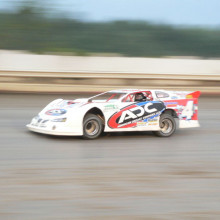
52:07 - How fast do I have to go to be lifted off the ground?
How fast do I have to go to be lifted off the ground?
We posed this question to Dr Hugh Hunt from the University of Cambridge...
Hugh - Well I suppose if we're trying to figure out how fast you need to go in a car and somebody grabbed a hold at the back, and you're try to lift them up off the ground, it's all about aerodynamic drag. The aerodynamic drag, there's a formula for it which is the half ρ V2 multiplied by frontal area, multiplied by drag coefficient. Now ρ is the density of air and that's 1.2 kg/cubic metre - that's easy. V is the speed of the car in meters per second. A is the frontal area of the person. Now, let's make a rough guess, it's a 10-stone person, so they're reasonably slim, a couple of meters high, say on average, 20 centimetres wide, wider in the middle, thinner at the legs. It's as good guess as any, so that gives them a frontal area of 0.4 square meters.
The drag coefficient, well, we need to make another guess here because the air behind the car is very turbulent. It's impossible to know what the drag coefficient would be, but let's say 0.5 - that's a reasonable figure, I think.
So if you do these sums, so the drag force is roughly equal to the weight of the person, then you end up needing to drive at about 160 miles an hour.
Well, is that reasonable? Look, it's such a complicated airflow behind the car and there are questions about when does a drag become lift? Once the person's out at an angle of 45 degrees then you might start thinking, we need to calculate the lift on the person rather than the drag on a person. We could have lots of arguments over this over a few beers if you want, but at least that's my start up calculation.










Comments
Add a comment